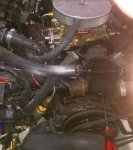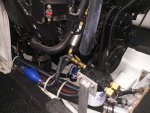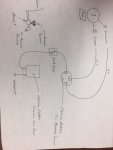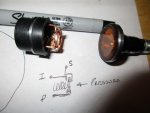Quarterwave
Petty Officer 2nd Class
- Joined
- Sep 16, 2013
- Messages
- 118
Hi everyone,
I'm trying to incorporate an electric fuel pump into a 5.7 Mercruiser.
The prior engine (5.0) had a mechanical fuel pump but the replacement engine does not have all of the holes for the mechanical fuel pump built into the block.
Some notes:
1) The replacement engine is on an engine stand in a garage, so I have full access to all the components.
2) The electric fuel pump is a Carter model (P4389 if I recall correctly).
3) I mounted the pump in the same location as the mechanical pump (using a bracket) and have all the fuel hoses (A1 type) connected to the water/fuel separator and also to the carburetor.
3) I have cleaned up the wiring harness from the old engine, but will need to replace most of the connectors as they are corroded.
4) I have little knowledge regarding electrics but a lot of common sense and building experience (engines and houses).
That all being said, can anyone steer me in the right direction and impart some knowledge to help me make the pump deliver fuel to the engine as required, and control the fuel system via the main ignition on/off key?
I have no extra wiring lying around etc... so anything other than the pump and hoses will need to be mentioned, so that I can buy what is needed.
Any help is very much appreciated.
Thank you.
I'm trying to incorporate an electric fuel pump into a 5.7 Mercruiser.
The prior engine (5.0) had a mechanical fuel pump but the replacement engine does not have all of the holes for the mechanical fuel pump built into the block.
Some notes:
1) The replacement engine is on an engine stand in a garage, so I have full access to all the components.
2) The electric fuel pump is a Carter model (P4389 if I recall correctly).
3) I mounted the pump in the same location as the mechanical pump (using a bracket) and have all the fuel hoses (A1 type) connected to the water/fuel separator and also to the carburetor.
3) I have cleaned up the wiring harness from the old engine, but will need to replace most of the connectors as they are corroded.
4) I have little knowledge regarding electrics but a lot of common sense and building experience (engines and houses).
That all being said, can anyone steer me in the right direction and impart some knowledge to help me make the pump deliver fuel to the engine as required, and control the fuel system via the main ignition on/off key?
I have no extra wiring lying around etc... so anything other than the pump and hoses will need to be mentioned, so that I can buy what is needed.
Any help is very much appreciated.
Thank you.



























